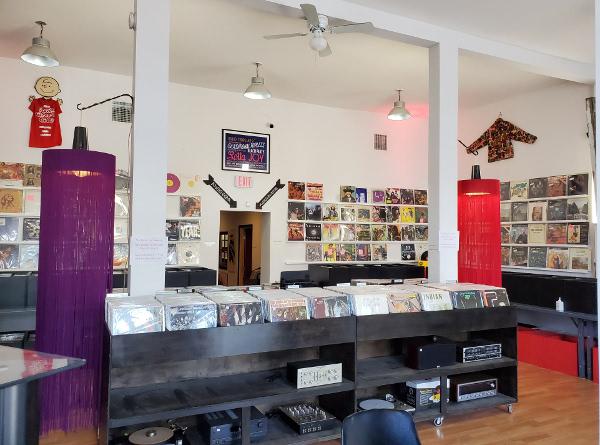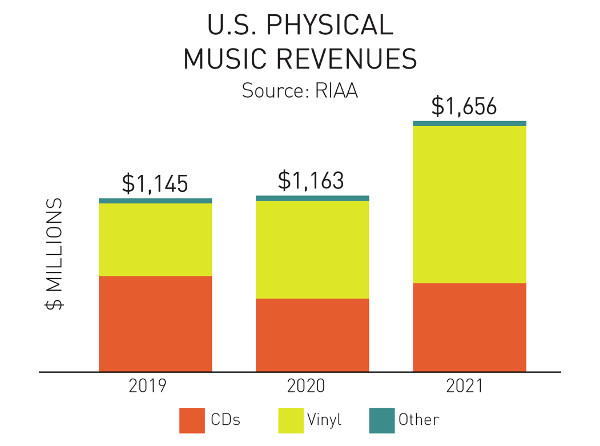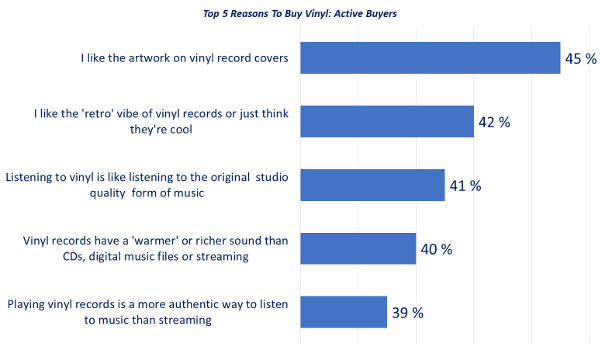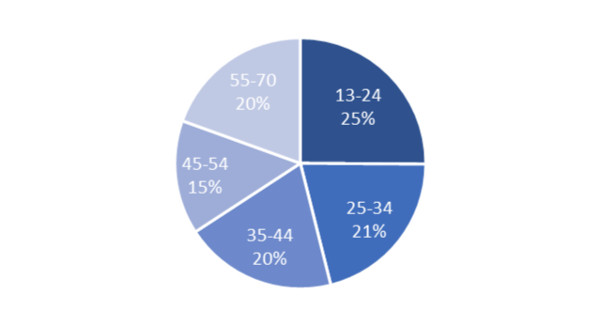Study Finds a Thriving Market for Vinyl Records

In the age of streaming where you can summon any song, band, or music genre in the snap of a finger, the lingering presence of vinyl records seems quaint — a fad embraced by hipsters, nostalgia seekers, and aging hippies. But the latest statistics from the Recording Industry Association of America (RIAA) show that the rebirth of vinyl that began more than a decade ago has real staying power.
The vinyl era of the 1960s and ’70s peaked in 1978 with unit sales of 341 million and revenue of $2.5 billion before a steady decline that bottomed out at $14 million in 2005. The following several years brought modest but steady upticks in LP sales and, by 2012, revenue had climbed its way back to $161 million with unit sales approaching 7 million.
The vinyl revival was on.
LP sales continued to grow at an accelerated pace over the next decade, reaching an impressive, if not shocking $1 billion by the end of 2021, representing close to 7% of all music revenue and 12% of total units sold with sales tallying up to 39.7 million albums. The move represented a staggering increase of 67% in unit sales and 61% in revenue over 2020. And, keep in mind, these numbers say nothing of the bustling market for used vinyl. I can walk or drive by Revilla Grooves and Gear on any given day and see multiple people — young and old — digging through bins of vintage vinyl, meticulously organized and carefully selected for the shop’s cadre of LP aficionados.

As the RIAA put it in its 2021 year-end analysis, the resurgence in sales of vinyl records has been going strong for 15 years with revenues that grew 61% over 2020: “The last time vinyl records exceeded $1 billion was 1986.” (In case you’re wondering, CDs are hanging in there, with 2021 revenues growing 21% to $584 million, the first year-over year increase in CD revenues since 2004.)
A Thriving Market
To learn more about the current surge in LP sales and what’s behind it, MusicWatch surveyed 1,400 consumers across the U.S. in March and discovered a thriving marketplace. The Revelations About the Vinyl Revolution study announced last week revealed that 18 million consumers 13 and older bought records in 2021 and that nearly three-quarters (71%) of those who bought vinyl over the past two years purchased new records while 67% bought used LPs.
Shoppers across the board were so enthusiastic about vinyl that all but 5% of them said they expect to continue purchasing the classic music format over the next 12 months. An appreciation of the “authenticity” and “warmth” of vinyl records is a key motivating factor for one in four (38%) of those who have been buying LPs for more than 10 years, while those who began their vinyl journey more recently place greater value on the packaging and artwork of albums old and new.

So why are sales of records continuing to grow and, more to the point, why did they spike in such a dramatic way in 2021?
MusicWatch managing partner Russ Crupnick points to an attraction to vinyl among younger buyers who are helping create a more diverse customer base that complements and extends beyond hard-core vinyl veterans. Buyers between the ages of 13 and 44 represent two thirds of the recording buying public and bring with them the desire to support artists and a strong appreciation of the special products they create for their fans.
“Fans see buying vinyl as a way to support artists” that transcends streaming or just listening to music, Crupnick explains. “Ownership of their work provides more support with some buyers treating vinyl the same way they would a T-shirt — as merchandise to express fanship.”
Crupnick also sees the potential for music streaming to spur sales of vinyl, mimicking the role FM once played where you’d hear a song on the radio and go buy the album. The desire among younger buyers to own a physical product is bolstered a preference for current releases with high value placed on artwork and packaging over sound, though sound is also important. By contrast, “grizzled veterans are mostly about sound and deep collections,” Crupnick adds. “There are lots of different types of vinyl buyers.”

The study found that, far from being limited to vinyl, buyers are music lovers who take advantage of the latest streaming platforms. And a love of vinyl encourages a desire to improve their listening experience. One in three of survey respondents who own a turntable say they intend to upgrade their record player or other audio gear over the next 12 months.
“This research underscores the unique role that vinyl records are playing today,” observes RIAA CEO Mitch Glazier. “The report shows that vinyl helps fans support and connect with artists and the music they love in both old ways and new.”
The future of vinyl is bright. “There is an appetite to grow vinyl collections,” Crupnick says. “Ownership” and “listening to albums” emerged as important concepts and the research suggests a latent demand among many non-buyers. All of which leads him to recommend that the music industry continue to focus on and invest in features that matter to the vinyl buying public while maintaining a steady flow of new releases with compelling packaging from popular artists.
























































